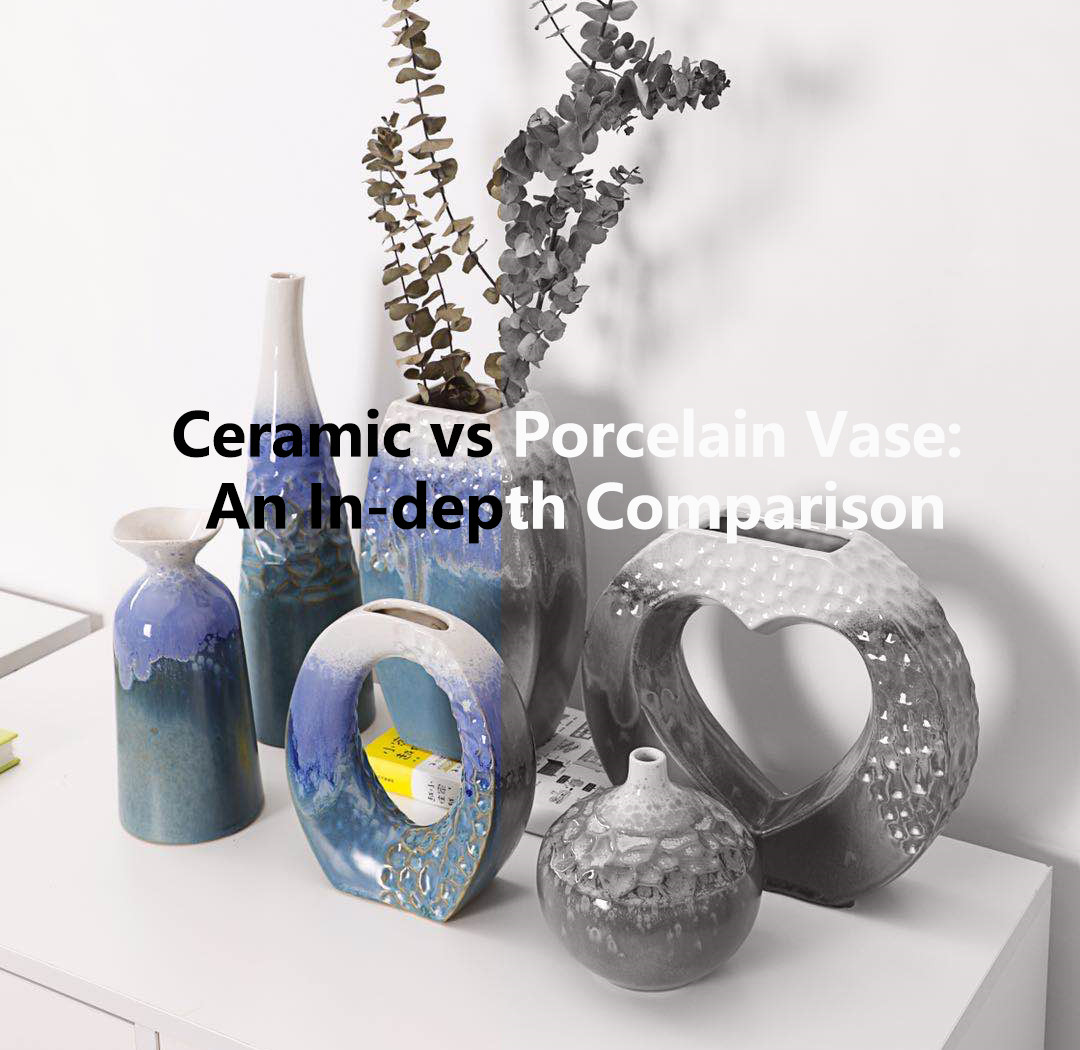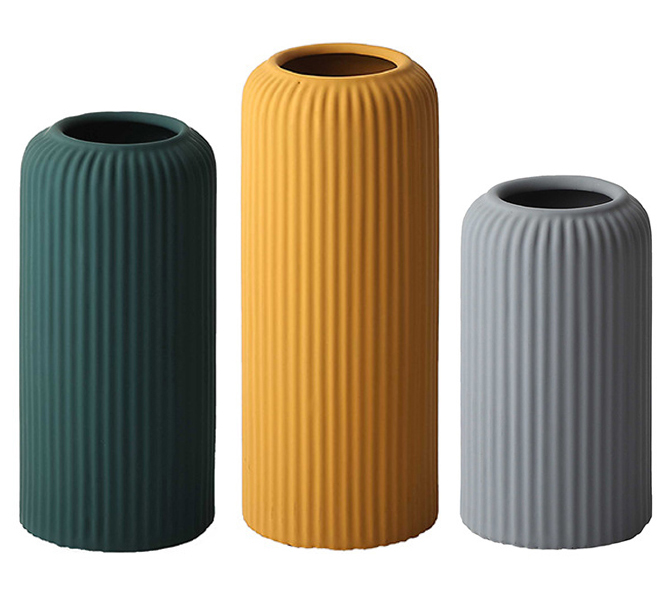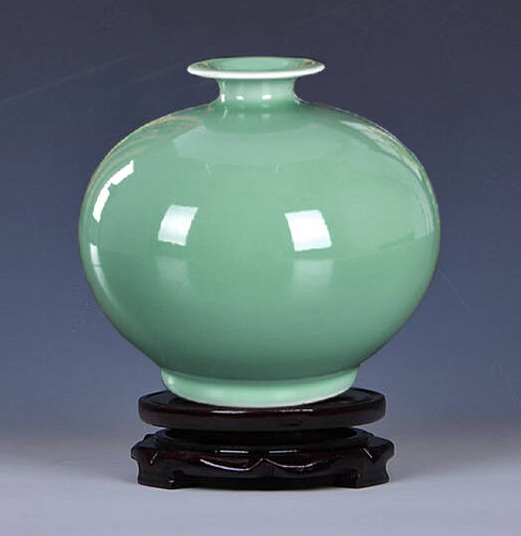Ceramic vs Porcelain Vase: An In-depth Comparison
Time of issue: 2024-01-30 15:33:35For centuries, vases have held a special place as both functional and decorative items in homes and various settings. With their wide range of shapes, sizes, and materials, vases offer versatile options for enhancing interior design. Among the most favored materials for crafting vases are ceramic and porcelain. Although they might appear alike at a cursory glance, ceramic and porcelain vases boast unique features, distinct production techniques, and rich historical backgrounds. In this in-depth guide, we will thoroughly explore the disparities between ceramic and porcelain vases, delving into their origins, manufacturing methods, aesthetic attributes, and practical uses.

What is Ceramic Vases?
Ceramic vases are beloved for their versatility and unique aesthetic. To appreciate ceramic vases fully, it's essential to understand their composition, production methods, and the myriad styles they encompass.

1.1 Composition of Ceramic Vases
Depend on to NOMLIVING. There are three main types of pottery/ceramic. These are earthenware, stoneware and porcelain. The term "ceramic" is a broad umbrella that covers a range of pottery types, including earthenware, stoneware, and porcelain. In the context of ceramic vases, they are usually crafted from clay, a naturally occurring substance found in the Earth's crust. The choice of clay varies, and this choice significantly influences the appearance and characteristics of the ceramic vase.
1.2 Production Process of Ceramic Vases
The production of ceramic vases involves several essential steps:
a) Clay Preparation: The chosen clay is extracted, purified, and refined to remove impurities, making it suitable for pottery. This clay is often mixed with other materials to achieve desired characteristics.
b) Shaping: Artisans shape the clay into the preferred vase design, employing various methods such as handcrafting, molds, or a potter's wheel. This pivotal stage offers room for creativity and design decisions, leading to a diverse array of shapes and sizes for the final ceramic vase product.
c) Drying: The formed vase is then set aside for air drying positioned within a controlled drying environment, allowing the removal of any surplus moisture from the clay.
d) Firing: Following the drying process, the vase undergoes firing in a kiln, subject to temperatures typically falling within the range of 1,832 Fahrenheit (1,000 degrees) to 2,192 Fahrenheit (1,200 degrees), with the specific temperature contingent on the type of ceramic being manufactured. This firing procedure serves to solidify the clay, resulting in a robust and enduring material.
e) Glazing (optional): Depending on the desired design, glazed ceramic vases are treated with a glazing process, which entails the application of a liquid mixture containing minerals and oxides onto the surface before firing. This glazing procedure is responsible for imparting color, texture, and a glossy finish to the vase, catering to specific design requirements. Ceramic glaze water at different firing temperatures is also different.
1.3 Appearance and Characteristics of Ceramic Vases
Ceramic vases offer a diverse range of appearances and characteristics, influenced by factors such as the type of clay used, the firing temperature, and the presence or absence of glaze. Some key features of ceramic vases include:
a) Versatility: Ceramic vases display exceptional versatility, available in a wide spectrum of colors, textures, and finishes. They can be matte or glossy, featuring smooth or textured surfaces, and their design possibilities are virtually limitless.
b) Texture: The texture of ceramic vases can vary from sleek and polished to rugged and rustic. This variability in textures enables the creation of vases that cater to diverse design preferences.
c) Aesthetic Variety: Thanks to their design flexibility, ceramic vases can be found in a plethora of styles, ranging from minimalist and contemporary to intricate and traditional. This versatility makes them suitable for a broad spectrum of interior design concepts.
d) Cost: Ceramic vases are generally more budget-friendly when compared to porcelain vases, making them an appealing choice for individuals in search of decorative items that won't strain their finances.
e) Durability: While ceramic vases are durable, it's important to note that they are not as robust as porcelain counterparts due to their lower firing temperature. This means they may be somewhat more susceptible to chipping or cracking when subjected to significant impact.
What is Porcelain Vases?

Porcelain vases are frequently linked with opulence, refinement, and enduring beauty. Gaining insights into the traits, historical background, and manufacturing methods of porcelain vases holds significant importance for individuals aiming to infuse a sense of sophistication into their living spaces.
2.1 Composition of Porcelain Vases
Depend on TMORA. Sometimes referred to as china, porcelain was invented in China in distant antiquity. The Chinese made porcelain of kaolin (white clay) and petuntse, a stone composed of feldspar, mica, and quartz. Porcelain that closely follows the Chinese recipe is known as “true” or hard-paste porcelain. The two other kinds of porcelain are soft paste and bone china.
Porcelain is a specific type of ceramic that is renowned for its exceptional quality, translucency, and durability. The primary ingredient in porcelain is kaolin clay, which is known for its fine particle size and purity. This unique clay, along with the firing process, gives porcelain its distinct properties.
2.2 Production Process of Porcelain Vases
The crafting of porcelain vases involves a meticulous and labor-intensive process:
a) Clay Preparation: It all begins with the extraction of kaolin clay, which then undergoes meticulous refinement to eliminate impurities. The end result is an exceptionally pure clay, crucial for achieving the desired translucency.
b) Shaping: Shaping porcelain vases requires exceptional precision, often entrusted to skilled artisans. Given the delicate nature of porcelain, it demands careful handling to prevent any deformities during the shaping phase. Porcelain vases are more easily deformed than ceramic vases, and their yield is lower.
c) Drying: Following their formation, porcelain vases undergo a controlled drying process to eliminate moisture without compromising their structural integrity.
d) Firing: Porcelain vases are subjected to extremely high temperatures during firing, typically ranging from 2,012 Fahrenheit (1,100 degrees) to 2,912 Fahrenheit (1,600 degrees). This intense heat fuses the particles, resulting in a vitrified and non-porous surface.
e) Glazing: The glazing of porcelain vases is a common practice, and it is executed with precision and expertise. The application of glaze not only enhances the vase's visual appeal but also offers protection and contributes to its distinctive sheen.
2.3 Appearance and Characteristics of Porcelain Vases
Porcelain vases are celebrated for their exquisite appearance and unique qualities:
a) Translucency: Porcelain is known for its translucent quality, allowing light to pass through its thin walls. This gives porcelain vases an ethereal and luminous quality that is unmatched by other ceramics.
b) Smooth Finish: Porcelain vases typically feature a smooth and glossy finish, which can highlight intricate patterns, delicate hand-painted designs, or subtle textures.
c) Elegance: The refined appearance of porcelain vases lends an air of sophistication and luxury to any space. They are often associated with classic and timeless design.
d) Collectibility: Porcelain vases are highly collectible, and many antique porcelain vases command significant value due to their rarity and historical significance.
e) Durability: Porcelain vases are exceptionally durable, as they are fired at such high temperatures that they become vitrified and impervious to water absorption. They are less likely to chip or crack compared to ceramic vases.
f) Because porcelain vases are fired at a higher temperature, they are more easily deformed than ceramic vases, and their yield is lower. So the price will be higher.
Choosing Between Ceramic and Porcelain Vases
Now that we have thoroughly explored the characteristics, production methods, and practical uses of ceramic and porcelain vases, it's time to discuss how to make the right choice when purchasing one of these beautiful art pieces.
3.1 Factors to Consider
When it purchase to selecting between ceramic and porcelain vases, consider several essential factors:
a) Intended Use: Start by thinking about how you plan to use the vase. If its primary purpose is to hold fresh flowers, a porcelain vase is the superior choice due to its water-resistant properties. For dried or artificial arrangements or simply as a decorative piece, ceramic vases provide a broader range of possibilities.
b) Design Aesthetic: Take into account your overall interior design style. Ceramic vases are exceptionally versatile and can seamlessly fit into a variety of settings, spanning from contemporary to rustic. On the flip side, porcelain vases introduce an elegant and timeless touch that harmonizes well with more traditional or formal spaces.
c) Budget: Ceramic vases generally come with a more budget-friendly price tag compared to porcelain vases, making them an appealing option for those who wish to adorn their space without overspending.
d) Shaped: For common shapes such as cylinder shapes. Porcelain vases are available, but their minimum order quantities are usually higher. For vases with special shapes or edges, use ceramic vases that are softer and have a higher yield.
3.2 Personal Preference
Ultimately, your personal preference should weigh significantly in your decision-making process. Your emotional connection to a vase's design, color, texture, and overall aesthetic is pivotal. When choosing between ceramic and porcelain vases, trust your instincts and opt for the one that resonates with you the most.
3.3 Mixing and Matching
There are no strict rules dictating that you must exclusively opt for either ceramic or porcelain vases. Combining and juxtaposing various materials, textures, and styles can result in a visually captivating and dynamic decor. For instance, you might consider pairing a porcelain vase with a ceramic one to create contrast and intrigue within your design scheme.
Conclusion
Ceramic and porcelain vases hold a timeless allure as decorative pieces that have graced homes and spaces for centuries. By gaining insights into their distinctions in terms of composition, production methods, appearances, and practical uses, you'll be equipped to make an informed decision when selecting the ideal vase to suit your needs and preferences.
Whether you opt for the versatility and cost-effectiveness of ceramic vases or the sophistication and resilience of porcelain vases, keep in mind that your choice should be a reflection of your personal style, a complement to your interior design, and a source of daily delight. Ultimately, the beauty and charm of a well-chosen vase will elevate your living space and serve as a timeless focal point that continues to captivate for years to come.
RECENT POSTS
- The Benefits of Wholesale High-Quality Ceramic Products for Retailers
2025-12-17
- Can You Make an Ashtray with Air Dry Clay? Pros, Cons, and Safer Alternatives
2025-12-17
- The Impact of Ceramic Materials in Energy-Efficient Buildings: Benefits and Applications
2025-12-04
- Top 7 Ceramic Cookware Health Benefits: Why It’s a Safer Choice for Your Kitchen
2025-12-04
- How to Clean Ceramic Planters and Improve Their Lifespan?
2025-11-17
- 15 Best Ceramic Holiday Gift Ideas for 2025: Thoughtful, Elegant & Heartfelt
2025-11-17
- Stoneware vs Porcelain vs Earthenware: Quick Decision Guide
2025-10-09
- Are Ceramic Glazes Food Safe? The Truth Behind the Shine
2025-10-09










